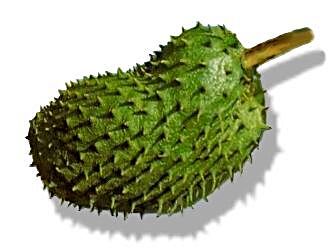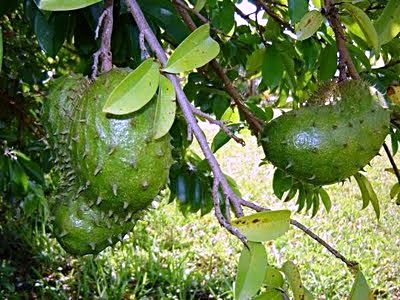 Soursop (Annona muricata) Guanabana or Graviola, also known as Guyabano in the Philippines, is known as large and versatile fruit. Soursops are highly popular around the world, but are rarely found fresh outside of the tropical areas in which they are grown. The plant is grown as a commercial crop for its 20-30 cm /7.87-11.8 inch long prickly green fruit, which can have a mass of up to 2.5 kg/5.5 lbs. The flesh of the fruit consists of an edible white pulp and a core of indigestible black seeds. Its flavor is described as a combination of strawberry and pineapple with sour citrus flavor notes contrasting with an underlying creamy flavor reminiscent of coconut or banana. The species is the only member of the genus Annona that is suitable for processing and preservation. The sweet pulp is used to make juice as well as candies, sorbets, and ice cream flavorings. The flesh of the fruit consist of a white edible pulp that is high in carbohydrates and considerable amounts of Vitamin C, Vitamin B1, Vitamin B2, Potassium and dietary fiber. Guyabano is low in cholesterol, saturated fat and sodium.
Soursop (Annona muricata) Guanabana or Graviola, also known as Guyabano in the Philippines, is known as large and versatile fruit. Soursops are highly popular around the world, but are rarely found fresh outside of the tropical areas in which they are grown. The plant is grown as a commercial crop for its 20-30 cm /7.87-11.8 inch long prickly green fruit, which can have a mass of up to 2.5 kg/5.5 lbs. The flesh of the fruit consists of an edible white pulp and a core of indigestible black seeds. Its flavor is described as a combination of strawberry and pineapple with sour citrus flavor notes contrasting with an underlying creamy flavor reminiscent of coconut or banana. The species is the only member of the genus Annona that is suitable for processing and preservation. The sweet pulp is used to make juice as well as candies, sorbets, and ice cream flavorings. The flesh of the fruit consist of a white edible pulp that is high in carbohydrates and considerable amounts of Vitamin C, Vitamin B1, Vitamin B2, Potassium and dietary fiber. Guyabano is low in cholesterol, saturated fat and sodium.
In many countries, soursops are believed to have medicinal properties as well. The diuretic effects of the ripe fruit are commonly used as a remedy for urethritis. The sap of the leaves is also believed to have healing properties, and can be used as a poultice to relieve swelling and eczema. The fruit, seeds, and leaves have a number of herbal medicinal uses among indigenous peoples of regions where the plant is common. The tea, fruit, and juice are used medicinally to treat illness ranging from stomach ailments to worms. Pulverizing the guyabano seeds and mixing it with soap & water is used as effective spray against caterpillars, armyworms and leafhoppers on plants.
Guyabano is generally grown as a backyard crop. The area devoted to it averaed 3,0816.6 hectares from 1980 to 1985. Western Visayas had the biggest hectare (740) , followed by Central Luzon (518). The average Philippine production during the same period was 3.31 tons per hectare. Average total production per year was 10,200 tons worth about 8.6 million pesos.
Production of Guyabano or Soursop
Adaptation
Guyabano thrives in a wide range of soil types with a pH ranging from 4.3 to 8.0 Well-drained soil with high organic matter content is highly desirable.
Acidic soil (pH 4.3 to 5.5) is not conducive to good growth because of the toxic effects of acid producing elements like aluminum, iron and manganese.
Soil acidity can be corrected by the application of lime. Agricultural lime can be used but it takes more quantity and a longer time to effect change, unlike hydrated lime or quick lime.
Frequency of lime application depends on the acidity of the soil, soil texture, and extent of crop removal of calcium and magnesium.
Guyabano needs a warm, dry climate during its flowering period. Such a climate favors good fruit set formation as it is generally as cross-pollinated tree. Adequate soil moisture, however, is required for good fruit development. It takes about four months from flowering until fruit maturity.
Guyabano Cultivars
Based on fruit taste, there are two strains – sweet and sour . They are botanically similar. Both grow up to seven meters tall. The leaves are alternative oval, pointed at both ends smooth and shiny, seven to 20 centimeters long, and with very short petioles. The flowers are large, heart-shaped, and yellowish or greenish yellow.
Propagation
Guyabano is generally propagated by seeds selected from fully mature fruits. A good-sized fruit mature fruits. A good-sized fruits weighs at least 750 grams and consists of94 percent pulp or meat; 11 percent peel; two percent core and three percent seeds. Seeds from 14 selected fruits are needed to plant one hectare wit a plant population of 625 trees.
Guyabano may also be propagate asexually, but it’s not common practice because trees grown from seed – sexual propagation – start flowering three years after planting.
In Guimaras, we had seedlings that started bearing 18 months after outplanting. When transplanted, the seedlings were six months old.
Asexually propagated trees, therefore, have no distinct advantage over sexually grown seedlings. The seeds should be sown in seedboxes or seedbeds. Seedlins that grow at least four leaves should be transferred to plastic bags. The soil medium for the bags should consist of sterilized loam soil and organic matter. Water the seedlings at least once a day during hot days.
Two to three weeks after you transfer the seedlings, apply a fertilizer solution every four days to accelerate plant growth and root development. Dissolve 100 grams of 14-14-14 per 17 liters of water and use this solution to water the seedlings. It is best to apply the solution at the base of the seedlings to avoid injuring young leaves. Two weeks before outplanting, reduce watering and expose the seedlings to sunlight to harden them.
Land preparation
Clear the field bu underbrushng and plowing. Allow the weeds to decompose before harrowing. Two or more harrowings are needed to thoroughly prepare the land. Provide drainage canals or make contours if the field is slightly rolling to avert soil erosion. Dig holes measuring 2 x 2 x 2 feet and refill with surface soil and organic matter.
Spacing and outplanting
A 4 x 4 meter spacing scheme – or 625 trees per hectare – is suggested for light-texture soils. Wider spacing is recommended for clayey soil. Outplant at the start of the rainy season to give the seedlings time to develop good root systems before the dry months. Remove the plastic bags before setting the seedlings in the holes.

Fertilization
For basal fertilization, apply five kilograms of chicken manure or other organic matter, plus 100 grams of 14-14-14 per hole. Mix the fertilizer with surface soil before setting the seedlings.
Depending on soil structure and availability of soil moisture, subsequent fertilization should be on a quarterly or semi-annual basis, 1.e. at the onset of the rainy season and before the dry season starts. Clayey soil needs less frequent application of fertilizer than light or sandy soil.
To enhance rapid vegetative growth and profuse root development, apply a mixture of urea and 14-14-14. The amount of fertilizer depends on age of trees and native soil fertility. For non-bearing trees, 300 to 500 grams of urea per tree per year is recommended. For newly bearing trees, application may range from 750 grams to 1.0 kilogram of 14-14-14 plus 200 to 500 grams of muriate of potash (0-0-60) per tree per year. The use of potash will improve fruit quality. These rates should be increased as the trees become more productive and grow older.
The fertilizer should be applied in holes dug around the base of the trees where most of the feeding roots abound. Cover the fertilizer with soil to prevent loss through volatilization and water run-off.
Pruning
Remove water sprouts and interlacing branches and prune diseased branches. Protect the cut ends by painting with coal tar, paint or pesticide paste to prevent the entry of disease organisms.
Cultivation and Weeding
Shallow-plow the soil to suppress weed growth and prevent brush fires during the dry months. Remove unwanted plants growing around the trees; such plants compete with the trees for nutrients and moisture.
Mulching
The enormous quantities of organic matter produced in most farms make mulching necessary. Mulching is putting of partially, decomposed farm wastes like rice hull, straw, grass and other materials around the base of trees. Mulch conserves moisture and hinders weed growth. Mulching materials that decompose become organic matter which provides small amounts of plant food to the trees; mulch also improves soil structure.
Pest and Disease Management
Guyabano is attacked by scales, mealybugs, mites, nest-building ants and twig borers. Regularly spraying pesticides can control these pests. Common diseases- such as antracnose and pink disease – can be minimized by practicing sanitation and spraying the trees with fungicides like manzate, Dithane, copper and sulfur based chemicals. The grower should immediately remove and burn diseased tree parts to prevent the spread of diseases.
Maturity Indices
The fruits are mature when their skins turn shiny green and the spines are set far apart. The fruits are ripe when they turn slightly yellow.
Fruiting Season
Bearing trees start flowering in May and June . A second flowering occurs in November and December. Fruits may be harvested four months after flowering.
Harvesting
Gather fully mature but still hard fruits and place them in plastic crates or bamboo baskets. Line the sides of the baskets with newspaper to protect the fruits from bruises.
Source: Greenfields; Photos: yaehealth.blogspot.com